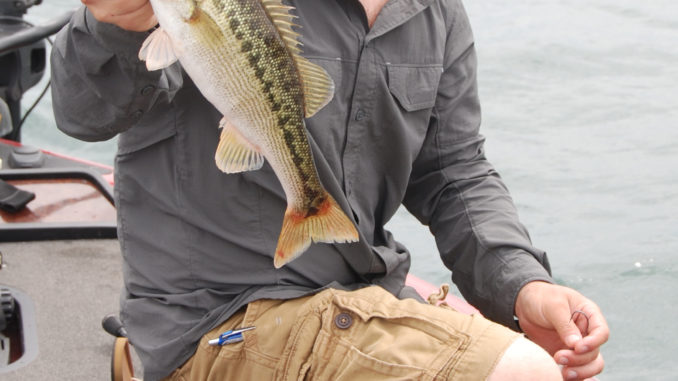
Summertime fishing at Keowee takes a 3-pronged approach. Early and late in the day, bass – primarily spotted bass – will use long points and humps to feed on the surface. As the day wanes, those same bass will move off into deeper water and suspend, just hang out like birds flying high in the sky, choosing not to relate to anything in particular. At the same time, what relatively little fish holding structure is available at Keowee, mostly in the form of boat docks and other manmade structure, will also draw a few fish looking for relief from the summer sun.
Guide Brad Fowler of Pendleton has been bass fishing Keowee since the days of his youth. He recalls when the predominantly largemouth bass fishery gave way to the spotted bass that were introduced back during the 1980’s.
“Spotted bass found Keowee to their liking, but because there wasn’t a lot of structure in the lake spots tend to swim together in packs and move vertically in the water column,” said Fowler (864-934-5813).
Beginning at first light and lasting for only an hour or so, spotted bass will move up on long points, humps and other terrain located close to deep water to corral and feed on baitfish. A hard bait like a Heddon Spook Jr, Lucky Craft Sammy or any number of noisy top water plugs can create a fury of action that comes and goes all too quickly.
“The remainder of the day, those fish just roam,” said Fowler. It’s like there’s no rhyme or reason. They might hold 40 feet deep over 100 feet of water or they may hold 20 feet deep over 60 feet of water. Your best bet is to just bump around using a drop shot rig or a shaky head worm.”
The final phase of summer Keowee bassin’ is man-made structure. Though the vast majority of Keowee’s shoreline is as well manicured below the surface as above, some docks will hold bass simply due to their preferred location over a natural drop off or other terrain feature. Some may be dotted with an old stump or even a few pieces of woody cover.
“Most bass look to boat docks for shade,” said Fowler. “A docked boat that hasn’t moved in a while may collect algae and some baitfish or bream, but for the most part, it’s relief from the sun that draws bass under docks. Also, because of the number of bass and so little structure, it’s not unusual to find a few bass still in a post-spawn pattern, sticking close to their old bedding sites.”


Be the first to comment